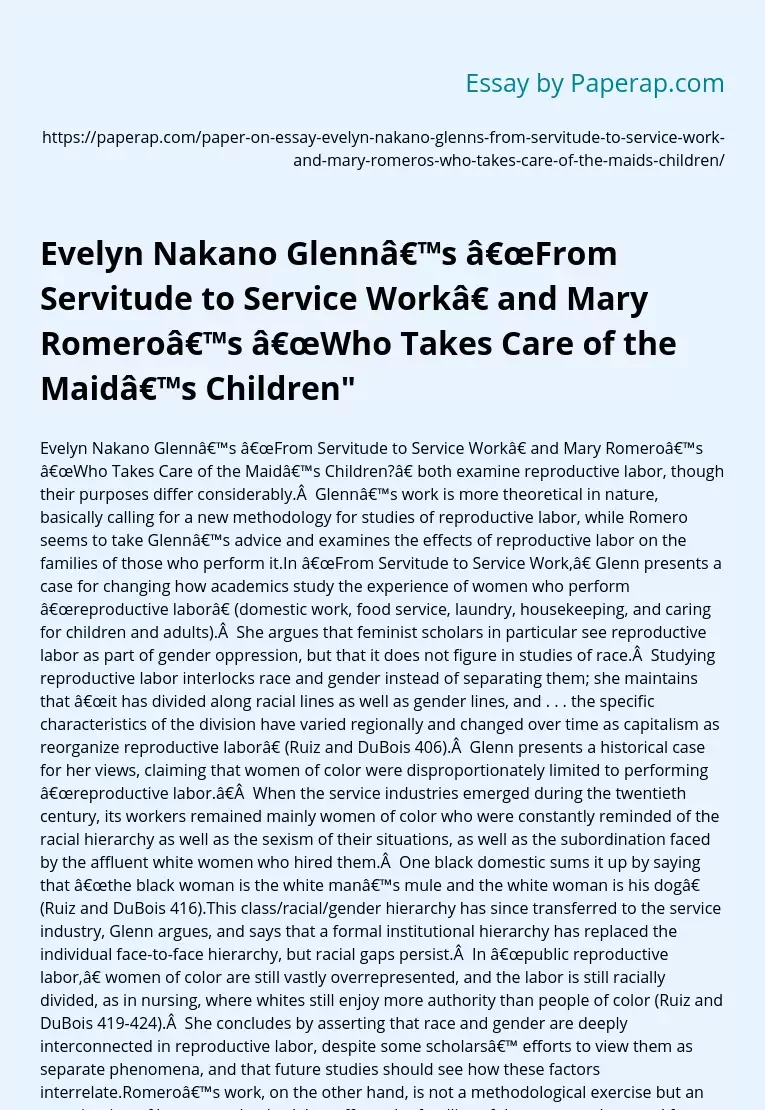Servitude & Service Work: A Comparison
The following sample essay on Evelyn Nakano Glenn’s “From Servitude to Service Work” and Mary Romero’s “Who Takes Care of the Maid’s Children?” both examine reproductive labor, though their purposes differ considerably.
Glenn’s work is more theoretical in nature, basically calling for a new methodology for studies of reproductive labor, while Romero seems to take Glenn’s advice and examines the effects of reproductive labor on the families of those who perform it.In “From Servitude to Service Work,” Glenn presents a case for changing how academics study the experience of women who perform “reproductive labor” (domestic work, food service, laundry, housekeeping, and caring for children and adults).
She argues that feminist scholars in particular see reproductive labor as part of gender oppression, but that it does not figure in studies of race. Studying reproductive labor interlocks race and gender instead of separating them; she maintains that “it has divided along racial lines as well as gender lines, and .
. . the specific characteristics of the division have varied regionally and changed over time as capitalism as reorganize reproductive labor” (Ruiz and DuBois 406). Glenn presents a historical case for her views, claiming that women of color were disproportionately limited to performing “reproductive labor.” When the service industries emerged during the twentieth century, its workers remained mainly women of color who were constantly reminded of the racial hierarchy as well as the sexism of their situations, as well as the subordination faced by the affluent white women who hired them.
One black domestic sums it up by saying that “the black woman is the white man’s mule and the white woman is his dog” (Ruiz and DuBois 416).This class/racial/gender hierarchy has since transferred to the service industry, Glenn argues, and says that a formal institutional hierarchy has replaced the individual face-to-face hierarchy, but racial gaps persist. In “public reproductive labor,” women of color are still vastly overrepresented, and the labor is still racially divided, as in nursing, where whites still enjoy more authority than people of color (Ruiz and DuBois 419-424). She concludes by asserting that race and gender are deeply interconnected in reproductive labor, despite some scholars’ efforts to view them as separate phenomena, and that future studies should see how these factors interrelate.Romero’s work, on the other hand, is not a methodological exercise but an examination of how reproductive labor affects the families of the women who cared for other people’s families. By studying the families of black and Latina domestics, she maintains that affluent white employers maintain their own lifestyles (and the class and racial hierarchy) at the cost of their domestics’ families, who are generally deprived of their mothers’ care and company. Romero illustrates the effects of the hierarchies that Glenn merely describes.She uses interviews with domestics’ children to show how their mothers’ long hours and often unfair treatment affected their own families. Sometimes, employers were kind to their maids’ children as long as suited them; that ended when the maid’s children experienced better living conditions and thus “no longer functioned to enhance and affirm the employer’s self-perception as kind and generous” (Nelson 153). In addition, maids often brought their children to work, where they were forced to play with their employers’ children (and were seldom treated well). Both situations demonstrated the facts that domestics and their families faced; even under good circumstances, they were never allowed to forget who dominated.The effects of reproductive labor on domestics’ families also included separation, when maids often had to take live-in positions away from their children for months or years at a time. In addition, Romero points out the “hidden costs” of reproductive labor, which included employers recruiting their maids’ children as unpaid workers, where they “were ascribed the same status as their mothers, and were treated as a source of cheap labor” (Nelson 159). It also including maids being forced to take home some of their work, like laundry and ironing, and were not compensated for the time or the cost of electricity. In addition, domestics’ families suffered from having less access to their own mothers and had to care for themselves unless other relatives were available. For domestics, says Romero, parenting became a privilege instead of a right, and the affluent family maintained itself at the expense of black or Latino families, whom the employers felt owed them something even after their service had ended.Glenn’s essay uses more theory than anecdotal evidence, since her work is clearly meant as a study of methodology and a proposal for a different model for studying domestic workers’ experiences. Her prose is a bit wordier and drier, but she makes her points clearly and presents a good argument for a new approach. Romero, on the other hand, seems to be acting on Glenn’s advice, using interviews and recollections to show how domestic workers were always reminded of their lower status, how that transferred to their children, and how fragile and dependent upon others the affluent white home actually was. Her prose is more engaging and she presents the domestics’ children’s memories clearly and effectively.These two essays demonstrate how reproductive labor intensifies the experience of class, gender, and racial hierarchy. Glenn claims that reproductive labor demonstrates how women of color race discrimination on more than one level, while Romero presents the stories of domestics’ children in order to show the side that whites (whether employers or not) rarely, if ever, witnessed. Taken together, these articles show how dependent many Americans were on the labor of other Americans and not only failed to appreciate it, but also felt they were entitled to the service and never saw the other side of the equation.
Servitude & Service Work: A Comparison. (2019, Jun 20). Retrieved from https://paperap.com/paper-on-essay-evelyn-nakano-glenns-from-servitude-to-service-work-and-mary-romeros-who-takes-care-of-the-maids-children/

